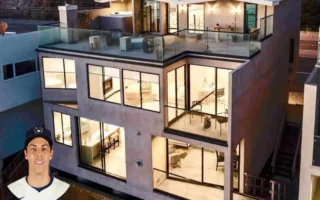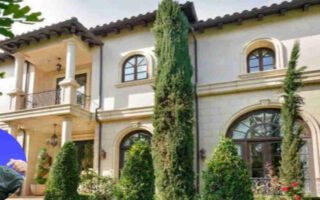The Luis Barragan House, also known as Casa Luis Barragan, stands as a masterpiece of modern architecture. Tucked away in the bustling heart of Mexico City, this iconic structure is more than just a home—it’s a profound representation of art, culture, and design innovation.
Luis Barragan, the architect behind this remarkable creation, left an indelible mark on the architectural world. His house is not just a reflection of his personality and philosophy but a testament to timeless design principles that continue to inspire architects and artists globally.
Luis Barragan: The Architect Behind the Masterpiece
To truly appreciate the Luis Barragan House, it’s essential to understand the man who envisioned it. Luis Barragan was not just an architect; he was a poet of spaces, a visionary, and a master of emotions through design.
Barragan’s Architectural Style and Philosophy
Barragan’s designs were a harmonious blend of modernist principles and Mexican traditional aesthetics. He had a deep appreciation for simplicity, colour, and the interplay of light and shadow. For Barragan, architecture was not just about structures; it was about creating spaces that evoked emotion, serenity, and intimacy.
Influences That Shaped the Luis Barragan House
Barragan was influenced by various cultural and artistic movements, including Mexican vernacular architecture, Moorish design, and European modernism. His travels through North Africa and the Mediterranean also shaped his use of vibrant colours and minimalistic forms. These eclectic influences are evident throughout the Luis Barragan House, making it a unique architectural gem.
Historical Context of the Luis Barragan House
The Luis Barragan House, constructed in 1948, was not just a residence but also a personal studio where Barragan could express his creativity. Located in the Tacubaya district of Mexico City, the house reflects the cultural and historical essence of post-revolutionary Mexico.
The Purpose and Location of the House
| Aspect | Details |
|---|---|
| Specifications | Built in 1947-1948; total area: 1,161 square meters; Concrete building with ground floor and two upper stories; includes a small private garden. |
| Architecture Design | Modern architecture with regional adaptation of International Modern Movement; Integration of modern design with traditional Mexican vernacular elements; Use of color, light, and texture; Features include skylights, windows tracking light, courtyard garden, low walls dividing spaces, wooden girders, minimalist stairways; Strong dialogue between light and constructed space; Color as substantial to form and materials; Emotional and sensory appeal; Water features influenced by Mediterranean and Islamic traditions. |
| Worth | Not explicitly stated in available sources; considered a priceless architectural and cultural heritage; Museum and UNESCO World Heritage Site, thus invaluable in art and architecture context. |
| Address | General Francisco Ramírez 12, Ampliación Daniel Garza, Miguel Hidalgo, 11840 Mexico City, CDMX, Mexico. |
| History | Built in 1948 as Luis Barragán’s personal residence and studio; Reflects his creative work post-World War II; Became a museum after his death in 1988; Declared a UNESCO World Heritage Site in 2004 for its outstanding universal value and influence on contemporary architecture and garden design. |
Barragan designed the house as a space for solitude and reflection, blending functionality with spirituality. Situated in a modest neighbourhood of Mexico City, the house’s unassuming exterior belies the beauty and depth of its interior. This juxtaposition of simplicity and complexity is a hallmark of Barragan’s work.
Cultural and Historical Influences
The house was built during a time when Mexico was redefining its cultural identity. Barragan incorporated traditional Mexican elements, such as stucco walls, courtyards, and the the use of natural materials , to pay homage to his heritage. At the same time, his minimalist approach aligned with the modernist movement sweeping through the architectural world.
Recognition as a UNESCO World Heritage Site
In 2004, the Luis Barragan House was designated a UNESCO World Heritage Site. This recognition highlights its global architectural significance and its status as a cultural landmark. The house is celebrated as an example of how architecture can transcend time and place to create something universally cherished.
Unique Architectural Features of the Luis Barragan House

One of the most captivating aspects of the Luis Barragan House is its unique architectural design. Barragan masterfully combined colour, light, space, and texture to create an environment that feels both intimate and infinite.
The Emotional Power of Colour
Barragan’s use of colour is revolutionary. From vibrant pinks and yellows to earthy tones, every hue in the modern house is carefully chosen to evoke a specific emotion. The bold pink walls, for example, contrast with the natural greenery of the courtyard, creating a sense of warmth and liveliness.
Colour was not just decoration for Barragan—it was a tool to shape the mood and atmosphere of each space. The psychological impact of these colours adds depth to the overall experience of the house.
Mastery of Light and Shadow
Natural light plays a central role in the Luis Barragan House. Carefully positioned windows and openings allow sunlight to filter in, creating dramatic shadows that enhance the textures of the walls and materials. This interplay of light and shadow transforms the space throughout the day, making it feel alive.
Seamless Integration of Indoor and Outdoor Spaces
Barragan’s design blurs the lines between indoor and outdoor environments. The house’s layout incorporates courtyards, gardens, and water features that invite nature into the living spaces. This seamless connection fosters a sense of tranquillity and harmony with the surroundings.
Minimalism with a Mexican Touch
While the house embraces minimalist principles, it also incorporates traditional Mexican aesthetics. The clean lines and uncluttered spaces are complemented by handcrafted elements, such as wooden beams, stucco walls, and rustic furniture. This fusion of modernism and tradition creates a timeless appeal.
Privacy and Serenity
Barragan valued privacy, and this is evident in the house’s design. High walls shield the house from the outside world, creating a sanctuary of peace. The internal spaces are designed to evoke a sense of intimacy, fostering reflection and introspection.
The Artistic Elements and Interior Design
The interior of the Luis Barragan House is as captivating as its architecture. Every detail, from the furniture to the artwork, reflects Barragan’s artistic vision.
Furniture and Decorations
Barragan’s interiors are characterised by simplicity and functionality. The furniture pieces, many of which were designed by Barragan himself, are minimalist yet comfortable. Natural materials, such as wood and leather, dominate, adding warmth to the spaces.
Use of Natural Materials
Barragan’s preference for natural materials is evident throughout the house. Stucco walls, wooden floors, and stone elements create a tactile connection to the natural world. These materials also enhance the sensory experience of the space, inviting visitors to touch and feel their textures.
Water Features and Gardens
Water features, such as fountains and reflecting pools, are integral to the house’s design. They add a sense of calm and create soothing sounds that enhance the ambience. The gardens, with their lush greenery, provide a stark yet harmonious contrast to the vibrant colours of the walls.
Integrated Artworks and Sculptures
Art plays a significant role in the house. Sculptures, paintings, and other artworks are thoughtfully placed to complement the design. Barragan believed in the unity of art and architecture, and this philosophy is evident in every corner of the house.
Visiting the Luis Barragan House Today

Today, the Luis Barragan House is open to the public as a museum. Visiting this iconic site is a must for architecture enthusiasts and anyone interested in experiencing the beauty of design.
How to Visit
The house offers guided tours that provide insights into its history and design. It’s advisable to book tickets in advance, as visitor slots are limited to preserve the site. Tours are available in both Spanish and English.
Visitor Experience
Exploring the luxury house is an immersive experience. From the moment you step inside, you’ll be captivated by the interplay of light, colour, and texture. Highlights include the rooftop terrace, the serene garden, and the iconic pink walls.
Tips for Visitors
- Photography Guidelines: While photography is permitted, the use of flash and tripods is not allowed.
- Nearby Attractions: After your visit, explore other architectural landmarks in Mexico City, such as the Casa Gilardi or the Convento de las Capuchinas.
Influence of the Luis Barragan House on Modern Architecture
The Luis Barragan House has had a profound impact on contemporary architecture. Its principles of simplicity, emotion, and integration with nature continue to inspire architects worldwide.
Inspirational Examples
Prominent architects like Tadao Ando and Frank Gehry have cited Barragan as an influence. His ability to create emotional spaces resonates with designers seeking to balance functionality and aesthetics.
Architectural Education and Preservation
The house is frequently studied in architectural programs, serving as a model for sustainable and human-centred design. Efforts are also ongoing to preserve its legacy for future generations.
Maintenance, Preservation, and Challenges
Preserving the Luis Barragan House is no small feat. Conservationists face challenges such as environmental wear and the impact of visitors. Despite these challenges, efforts continue to maintain its original charm while making it accessible to the public.
Where Does Luis Barragan Currently Live?
Luis Barragán is no longer alive, as he passed away on 22 November 1988.




